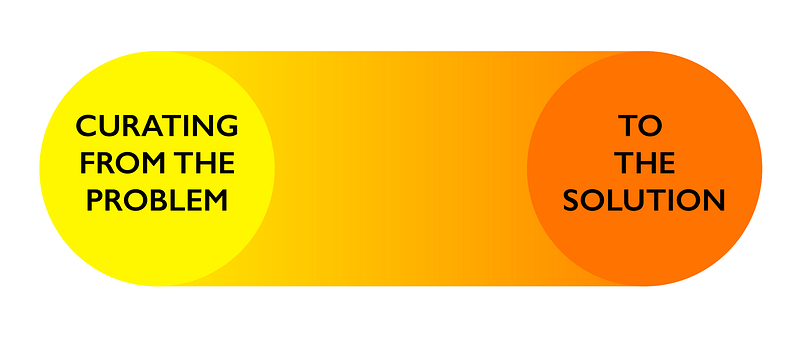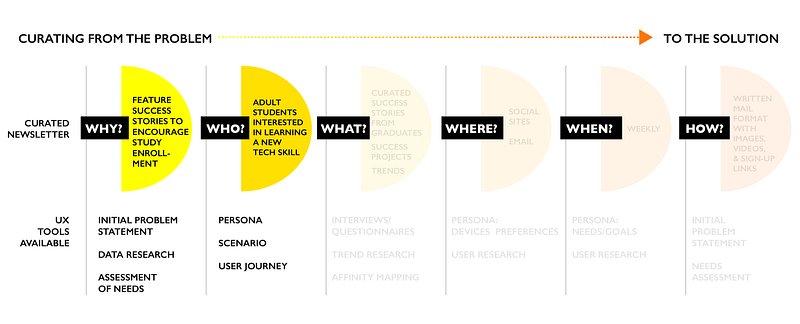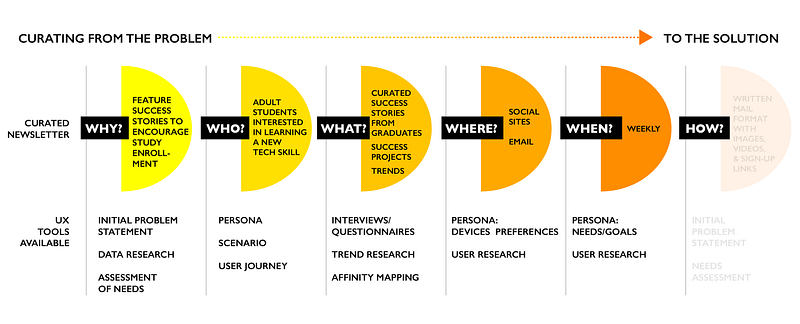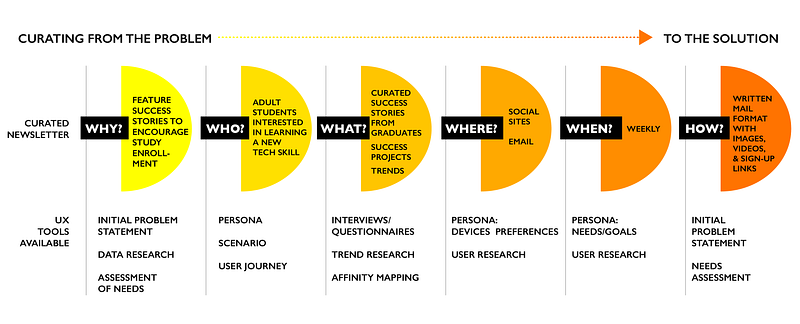CREATION MEETS UX
Great content curation done with key UX practices
How to identify content insights using the right UX tools

Content curation seems easy at first glance.
However, when digging deeper and spending time on curating an actual content experience, many questions rise to the surface. These can span the gamut of “What is it that I’m actually doing?” to “Where’s the source for this snippet of information?” to “I created my newsletter, now what?”
Any question in the realm of content curation is viable. As curators, we are the primary drivers of the content presentation.
The crucial list of questions a curator needs to answer, at least to her/himself, oftentimes to a larger team including clients and stakeholders, is referred to as the 5Ws1H.
The 5Ws1H: Why, who, what, where, when, how?
Content curation sources multiple points of input, with a beginning and end that can also be described as curating from stating the problem to presenting the solution.
For example, I want to curate a newsletter for my online class. My intent is to boost my student number. My path, using the 5Ws1H to define my curated content, looks like this:

The 5Ws1H queries can be answered in very simple terms, or the answers can get very elaborate if the base audience is large and the offerings complex.
Let’s explore the 5Ws1H!
First up: Why?
Similar to writing out a problem statement in a UX product development cycle, we need define the why, the intent of why we are curating this content. The why will is the foundation for our curatorial efforts.
The why can be defined as a need or problem. For example, I’m trying to build my user base for my online course.
I write out a problem statement for my own reference: My audience needs to see more relevant success stories to determine whether they should join an online class to successfully complete a project.
Then, I define my why as feature success stories to encourage student enrollment.

UX tools available to help define the why are: a problem statement , conducting data research with interviews, and also an assessment of needs based on user feedback.
Already, now that I’ve defined the why, I’m on a roll with my curation project!
Next: Who?
Content need to be useful and interesting to the audience we are curating for and be on topic. The who needs to be defined before we can start curating content. For example, we need to know whether we have an established audience or is the audience a brand-new group of customers?

Knowing the audience, the who, is key for successful content curation. There is a big difference whether we are curating for a particular age group, or a group that spans the gamut of all ages.
UX tools available for defining our who are user persona, a one-person data portrait that represents the entire audience. A user persona includes topics such as needs, motivations, goals, pain points, demographic and psychographic references, skill sets, and device preferences.
In addition to a persona, we can utilize scenarios (the place of the user’s interaction with the product) and user journeys (what tasks does the user need to perform to reach goal?)
These UX tools can be used as necessary. The important thing is to have a solid understanding of the audience we are curating for.
Third: What?
What we are curating greatly depends on the medium chosen. For instance, we can curate only digital content, or we can release digital content and simultaneously offer an in-person event, such as an in-person presentation or event.
In the example of the newsletter, the what is defined as a newsletter e-mailing.

UX tools that help define the what are personal interviews and questionnaires, trend research on sites such as Google Trends or Trend Hunter, and affinity mapping for identifying trends and topics.[1,2]
Next: Where?
The location where curated content will appear depends on the who. The audience itself drives the geo-specific content release. For example, this can be an online release of an educational book in the U.S. only, or it could be a video release intended for a world-wide study group.

In our example, the release of the newsletter, the where is simple: social sites and e-mailing.
However, if an exhibition with physical objects is curated, it might launch as a local exhibit, or also as a global traveling exhibit. These are two very different types of where. In each, the where needs to be identified as a real place and specificities.
UX tools available are insights from our user persona, such as device and location preferences. User research can provide additional data about the users’ engagement settings.
Last of the 5Ws: When?
A release date can be repetitive or a single event. A curated newsletter can be sent out weekly, bi-weekly, or once a month, whereas an opening night for a curated art show is likely to happen only once.

As we close in on the when in our content curation journey, we can see how this method provides a successful path. We know why we’re curating, for whom, what the content is going to be, where it will take place, and also, a realistic time frame, the when.
UX tools available to define when are insights from our user persona, such as their needs and goals. User research can provide additional data about the users’ daily and weekly habits and behaviors.
Lastly: How?
How it is all organized? How is the content presented? Is it chronological, or a mixed-time list? Is it a newsletter-type list or a personal podcast? There are many options.

To define the how, we can refer to the UX tools used at the beginning of the journey, the initial problem statement and assessment of user needs.
In the example of the email newsletter, media items such as images, videos, and sign-up links are outlined.
In our example, these are important add-ons to the featured user success stories. We’re having quite a full content for the curated newsletter!
The 5Ws1H are answered. Now experiment!
Once the curated content has been launched, we can experiment with different ways of presenting such content. The work is done, and we can explore different formats, such as a list, slideshow, podcast, ebook, animations and infographics, an event or exhibit.
Different styles of curation, such chronology or mixture of everything at once, can also be experimented with. Unique aspects of curated content can be featured in various ways.
Curated takeaways
The 5Ws1H content curation method leads the way and will make your content shine.
Every input topic of the 5Ws and the 1H ought to be defined, even if it’s a simple outline. It does not need to be complicated.
The mentioned UX tools can get used as seem fit and necessary. Most importantly, the initial problem statement and user persona need to be written out. Personal interviews should be conducted and distribution methods identified.
Can’t wait to see how you are curating your next content project.
References:
[1] Google Trends: https://trends.google.com/home
[2] Exploring trends: https://www.trendhunter.com/
All illustrations © Eva Schicker 2024.
